Idaho, being further north, doesn’t have as many snake species as other U.S. states. However, that doesn’t mean zero.
According to iNaturalist.org and Idaho Fish & Game, 12 snakes make their home in the Gem State. The most common are garters, racers, gophersnakes, and western rattlesnakes.
We’ll leave the rattlesnakes out of it for a moment, because you’re not as likely to see one hanging out in your Idaho garden. They tend to shun human habitats because they’re more shy and reserved than their reputation would otherwise indicate.
#1 Most Common Snake in Idaho Gardens: Garter Snakes (Thamnophis elegans and Thamnophis sirtalis)
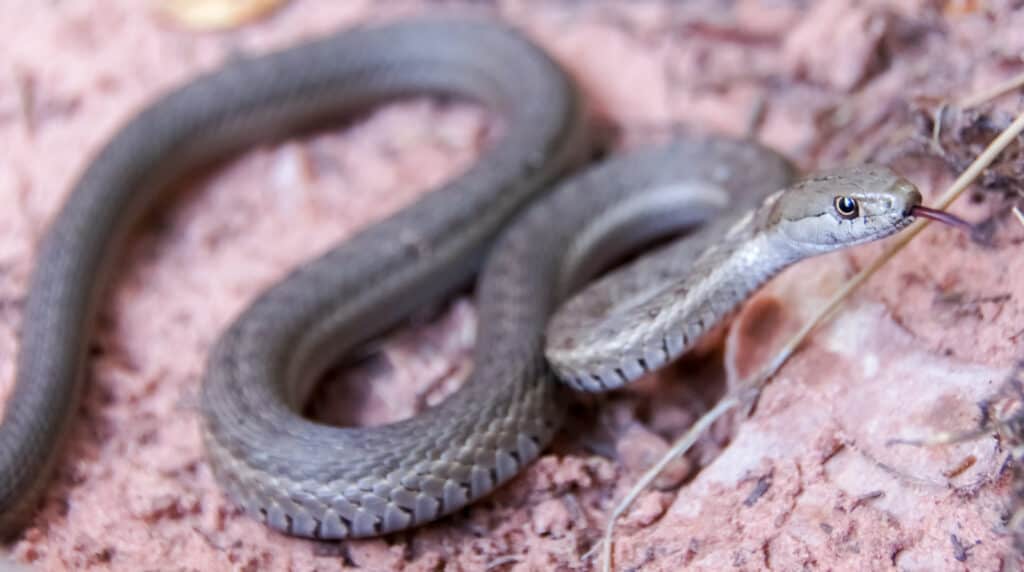
Western Terrestrial Garter Snake (Thamnophis elegans), Utah, USA. Snake extends forked tongue and takes on defensive posturing.
©iStock.com/yhelfman
Yes, we listed both garter snakes under one heading. In reality, if you’ve seen a garter snake, it’s pretty easy to identify it as a garter snake. However, it’s not always easy to identify which garter snake is in front of you, and sometimes even experienced herpetologists have trouble. It’s often easier to identify them correctly by showing a contrast between the two species.
That’s what we’ll do here.
The western terrestrial gartersnake (Thamnophis elegans) is by far the more common garter snake species in Idaho gardens. This species has several subspecies, all of which can vary in color and pattern from light brown to gray or olive green. They’re thin-bodied snakes that average between 18 and 41 inches long as adults.
Nearly all western terrestrial garter snakes have three stripes down the length of their bodies — a dorsal stripe and one stripe on either side, just above the belly. Between the stripes they may or may not have spots. The stripes themselves can be yellow to orange.
Of all the garter snakes, the western terrestrial garter snake is the only one that constricts its prey — even though it’s not as efficient a constrictor as a gopher snake.
Like most garter snakes, this species has large eyes with round pupils and a smallish head. Many of them also have vertical labial (lip) bars.
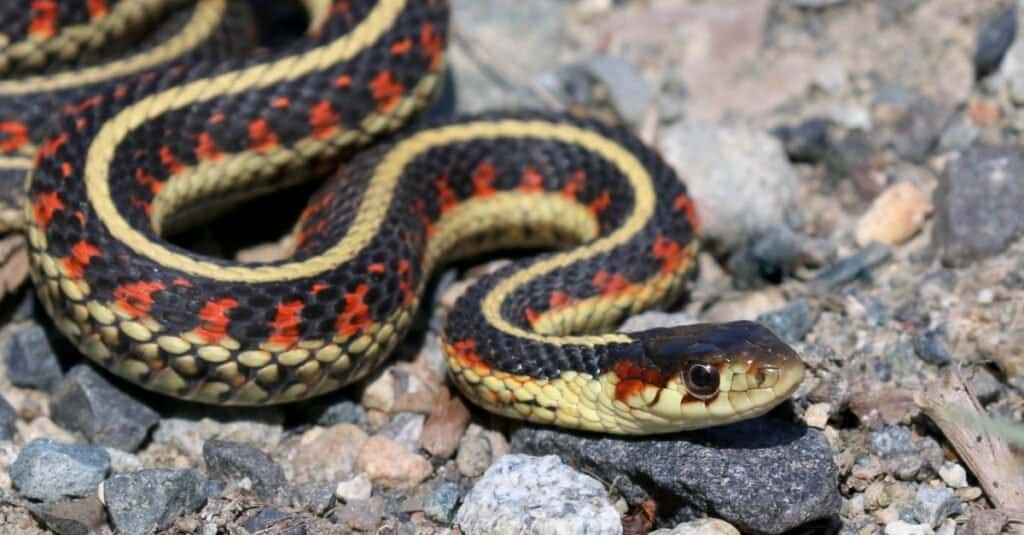
Valley garter snakes have larger eyes and smallish heads.
©iStock.com/randimal
In contrast, the common gartersnake (Thamnophis sirtalis ssp.) can grow over four feet long. These snake are more robust, but still have thin bodies for their length. Common garter snake subspecies’ appearances vary even more widely than their western terrestrial cousins.
There are at least a dozen common gartersnake subspecies spread across North America, as far north as southern Canada. Idaho’s most frequently encountered common garter snake subspecies is the valley gartersnake (Thamnophis sirtalis fitchi).
Its colors tend to be bolder than the western terrestrial garter and its dorsal line really stands out. The subspecies also has two lines on its sides and its base colors are usually darker and can be black. It makes that yellow or white dorsal line pop!
Valley garter snakes have larger eyes than average, round pupils, and a smallish head.
All garter snakes give live birth. Those babies take off pretty quickly after they’re born. Some scientists think this helps them survive colder temperatures than other species.
Garter snakes eat a variety of prey and will happily snack on grubs, worms, fish, frogs, and insects — which explains why you’ll probably find a garter snake in your Idaho garden.
Gopher Snake (Pituophis catenifer ssp.)
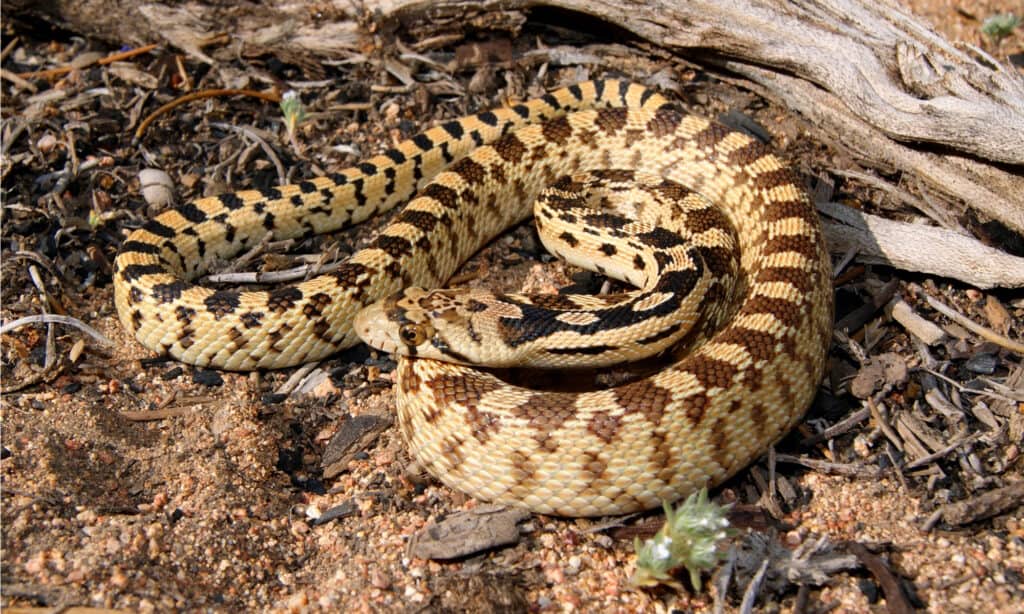
Great Basin Gopher Snake, Pituophis catenifer deserticola
©Matt Jeppson/Shutterstock.com
Gopher snakes may have more nicknames than brain cells, but that doesn’t stop them! Depending on where you live, you may hear about bullsnakes, gopher snakes, pine snakes, or blow snakes.
Scientists agree on six of the subspecies in Canada, USA and mainland Mexico. However, that’s where the agreement ends. There’s another discussion surrounding the populations in Baja California — which we will not explore in this article.
When you spot a gopher snake in an Idaho garden, it’s likely to be the Great Basin gopher snake subspecies of Pituophis catenifer deserticola. This subspecies is big, and can reach seven feet long. They have a lighter brown or tan base color with big dorsal (back) blotches and smaller side blotches.
Great basin gopher snakes have bigger heads with large, friendly eyes. However, when you corner one, it will to puff itself up, coil like a rattlesnake, and hiss. Loudly. That’s in addition to the creepy sound their scales make as they rub coils of their body together.
Yet, for all their bluster, gopher snakes are harmless. If they strike at you, it’s usually just their nose — yes, gopher snakes head butt you when they’re upset.
Many people mistake gopher snakes for rattlesnakes. If their markings weren’t enough for a case of mistaken identity, a gopher snake’s threat display would seal the deal.
But, these somewhat cranky snakes are harmless rodent hunters and help keep your Idaho garden free of pests.
North American Racers (Coluber constrictor ssp.)

Adult racers have solid color bodies and bellies.
©Michael Chatt/Shutterstock.com
These adorable and fast-moving snakes get their name from the fact that they can cruise along at four miles per hour. While that’s not much faster than most of us walk, it’s awfully fast for something with no legs.
Racers are long and thin, but not as thin as garter snakes. This species can reach about five feet long, but most average between two and four.
Young racers have similar patterns to young coachwhips and rat snakes — leading to misidentification in areas where they overlap. Their light base color and blotches over their back may confuse people, but those big friendly eyes do not.
As racers age, they lose their baby pattern and become one solid color on their back and lighter (but still solid) on their belly. Depending on where they live, they can range from green or blue to pitch black with yellow, orange, tan, white, or even black bellies.
North American racers (also called eastern racers) are harmless nonvenomous snakes, but they are feisty! This species operates on the idea that the best defense is a good offense. Corner one and you’ll see what we mean. Racers bite repeatedly and they aren’t gentle.
Their over-the-top defense mechanism aside, racers are amazing rodent control. They’re obligate carnivores and do not live on vegetables. Racers eat rats, mice, birds, sometimes eggs, lizards, frogs, toads, and anything else they can fit in their mouths.
North American racers are pretty common Idaho garden snakes even if you don’t see them everywhere. This shy species is more likely to beat scales out of your garden before you see them, but a racer in your yard means the rodent population is under control.
Northern Rubber Boa (Charina bottae)
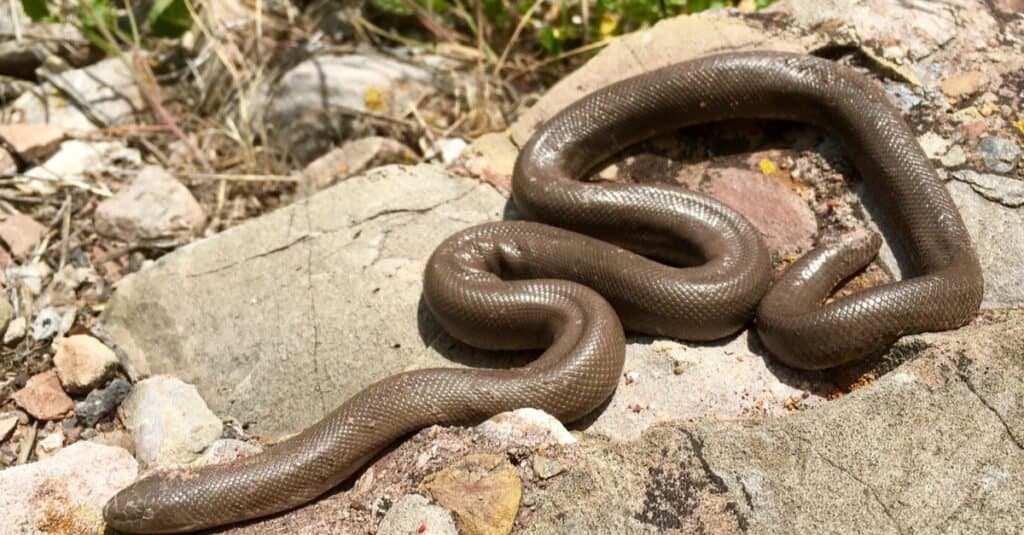
©Matt Jeppson/Shutterstock.com
Idaho may not have many snake species, but did you know that they have a boa species? It’s true! The northern rubber boa (Charina bottae) lives further north than any other boa species, and is one of two boid genera that live in North America (rosy boas are the other!).
Rubber boas look completely different than any of the other snake species that inhabits the same range. These odd little snakes measure between 1.25 and 2.76 feet long. Newborns (yes, they give live birth) are even smaller and are less than 10 inches long.
Although they’re not made of rubber, they look a bit rubbery — which is where they get their name. Rubber boas’ skin is loose and wrinkled with small shiny scales.
They’re solid-colored and usually vary from tan to dark brown with the odd olive-green, yellow, or orange individual thrown in for good measure.
The funniest thing about rubber boas is that their tails are as blunt as their snouts. It’s hard to tell where their head is at first glance. They have vertical pupils, but their eyes are so small it’s often hard to see.
You’re not as likely to find a rubber boa in your Idaho garden, but if you do it’s a treat! They’re very docile and almost never strike — rubber boas are often used to help people overcome their fear of snakes.
While they’re fairly common, rubber boas aren’t seen very often because they’re primarily nocturnal. These snakes eat small mammals like shrews, voles, and mice.
Other Nonvenomous Idaho Garden Snakes
There aren’t many more snakes to discuss in Idaho gardens. The state’s northerly location limits the number of reptiles that can successfully live there!
Sightings of most snakes peak around July to August and taper sharply before and after. Some, like the outrageously common garter snakes, can be active from February to November, but most have less time in the sun each year.
- Striped whipsnake (Masticophis taeniatus)
- Desert nightsnake (Hypsiglena chlorophaea)
- Ring-necked snake (Diadophis punctatus)
- Ground snake (Sonora semiannulata)
- Long-nosed snake (Rhinocheilus lecontei)
Venomous Snakes in Idaho Gardens
Idaho only has a couple of venomous snakes and they’re both rattlesnakes — among the most feared snakes in North America.
However, rattlesnakes don’t deserve the terrifying reputation. The vast majority of them are completely terrified of us.We are far bigger and definitely not on their menu. So, they see us as a threat.
Identifying rattlesnakes is pretty easy! That distinctive rattle at the end of their tail is a giveaway. But, if you’ve encountered a young snake you may only see the button — that’s where the rattle begins, but it won’t make any noise until there are a couple of links.
Identifying Pit Vipers
Rattlesnakes are part of a class of snakes called pit vipers. It’s a subfamily within the larger Viperidae family called Crotalinae.
Snakes in the Crotalinae subfamily possess heat sensing pits between their nostril and eye. The pits face forward and are located on the loreal scale (it’s why we sometimes call them loreal pits).
What makes rattlesnake loreal pits special is that they give the snake the ability to see heat in the dark. They can locate prey with the accuracy of a surgeon!
Rattlesnakes also have fangs that fold neatly into the roof of their mouth. Adding to the fun, their fangs attach directly to very large venom glands, making them able to inject a lot of venom at one time.
Pit vipers like rattlesnakes have vertical pupils that look like cat-eyes when they’re in bright light.
Idaho’s Rattlesnakes: Northern Pacific Rattlesnake (Crotalus oreganus) and Prairie Rattlesnake (Crotalus viridis)
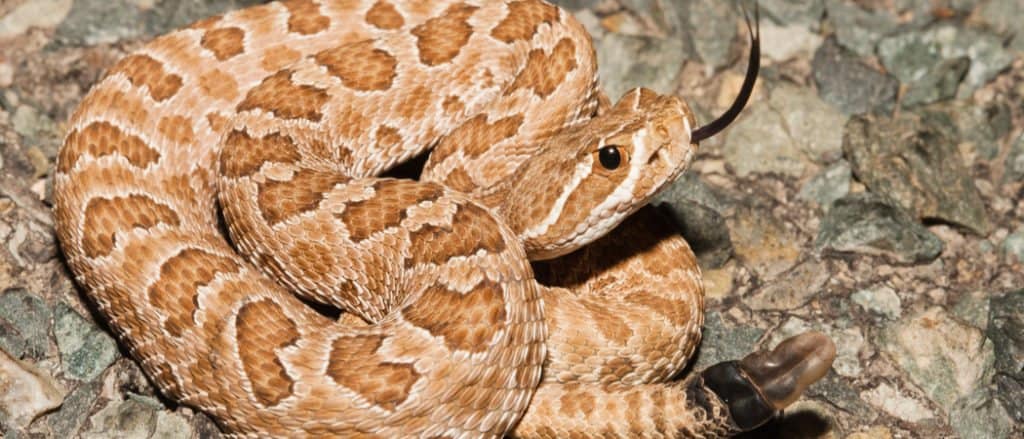
This young prairie rattlesnake doesn’t have a rattle yet!
©Nathan A Shepard/Shutterstock.com
There are over 50 rattlesnake species, but fortunately for Idaho residents, you’ll only find two resident rattlesnake species.
Adding to the confusion, the two species’ taxonomic history is complicated. Until 2001, many scientists recognized on species with a whole lot of subspecies. Widespread genetic testing showed that there were really only two main populations — one east of the Rocky Mountains and another west of the Rocky Mountains. Many of the subspecies remain, but they’ve been reclassified into C. viridis or C. oreganus subspecies.
You’re likely to encounter a prairie rattlesnakes (Crotalus viridis) in the foothills and valleys of eastern Idaho. They tend to prefer rocky outcrops that offer den sites and hiding places for prey. Like other snakes, they follow the food and shelter. These snakes sometimes climb bushes and trees after prey, but keep to the ground most of the time.
Prairie rattlesnakes can grow up to five feet long with thick bodies and big triangular heads. Their colors are usually light with white outlined darker blotches that blend into the habitat. Many prairie rattlesnakes darker stripes (not extremely dark) with light borders behind their eyes.
The northern Pacific rattlesnake (Crotalus oreganus) has similar patterns, but their colors are bolder. They often have a stronger contrast between the base color and blotches. Their ranges dont overlap too much, but they can.
In Idaho, northern Pacific rattlesnakes occur in the west and south. They typically stay within a few miles of their winter dens and will reuse the same one for years — often the same one where they were born.
Both rattlesnake species are highly venomous and will bite if they’re threatened — these are a medical emergency.
Safety with Idaho Garden Snakes
It’s a little cliche to say it, but snakes really are terrified of you. Although a fear of snakes is common, most snakes want to be left alone. They don’t want to get in your way because you are a bigger threat to them than they are to you — yes, even rattlesnakes. A rattlesnake bite may land you in the hospital, but many people kill rattlesnakes just for existing. So who’s really in danger?
Keeping your family and pets safe in your garden isn’t too difficult. There are two things you can do to help: Educate your kids and remove the food and shelter that attracts snakes.
- Educate. Teach your kids how to identify dangerous snakes and to leave all snakes alone. Make sure they know how to spot them and where they’re likely to hide.
- Keep your yard clear of debris.There are no plants or repellents that anyone’s proven reliable. Snakes follow the food and shelter. If you remove opportunities for prey animals to hide, then you also remove opportunities for snakes to hide. Double bonus.
The photo featured at the top of this post is © iStock.com/yhelfman
Discover the "Monster" Snake 5X Bigger than an Anaconda
Every day A-Z Animals sends out some of the most incredible facts in the world from our free newsletter. Want to discover the 10 most beautiful snakes in the world, a "snake island" where you're never more than 3 feet from danger, or a "monster" snake 5X larger than an anaconda? Then sign up right now and you'll start receiving our daily newsletter absolutely free.
Thank you for reading! Have some feedback for us? Contact the AZ Animals editorial team.






